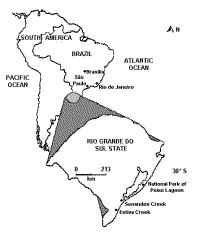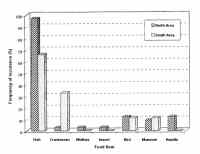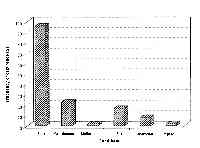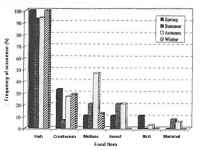 |
Last Update:
Thursday November 22, 2018
|
| [Home] |
|
Volume 17 Pages 1 - 58 (April 2000) Citation: Colares, E.P. & Waldemarin, H.F. (2000) Feeding of the Neotropical River Otter (Lontra longicaudis) in the Coastal Region of the Rio Grande do Sul State, Southern Brazil IUCN Otter Spec. Group Bull. 17 (1): 6 - 13 Feeding of the Neotropical River Otter (Lontra longicaudis) in the Coastal Region of the Rio Grande do Sul State, Southern Brazil Elton Pinto Colares and Helen Francine Waldemarin Laboratório de Zoofisiologia, Departamento de Ciências Fisiológicas, Fundação Universidade do Rio Grande, Caixa Postal 474, CEP 96200-970, Rio Grande, RS, Brazil (received 12th December 1999, accepted 28 January, 2000)
INTRODUCTION Studies on the feeding habits of different otter species have shown that they are mainly opportunists and feed on prey that are more abundant and/or species less active (ERLINGE, 1968; ADRIAN and DELIBES, 1987; OLIMPIO, 1992). Although there are large numbers of studies on the diets of Lutra lutra and Lutra canadensis, almost nothing is known about Lontra longicaudis. This despite its wide distribution, occurring from Mexico to the north of Argentina, studies on the feeding habits of this species in Brazil were made in the states of Sao Paulo and Espirito Santo, both in the central region of the country (PARDINI, 1998; HELDER-JOSÉ and DE ANDRADE, 1997). The present work aimed at the determination of the diet of the neotropical river otter, Lontra longicaudis, in the coastal region of the Rio Grande do Sul state, in the south of Brazil. MATERIAL AND METHODS The three study areas are in the coastal region of the Rio Grande do Sul state (Figure 1). This is Brazil's southernmost state, and exhibits a sub-tropical climate, markedly cold and rainy in winter, and hot and drier in summer. The coastal plain originated from successive progressions and retractions of the sea-level, which cut off large areas of the Atlantic Ocean, resulting in the largest lagoon complex in South America, being made up of the large lagoons of Patos, Mirim and Mangueira. There are also many wetland areas and a complex of smaller lagoons.
National Park of the Peixe Lagoon The National Park of the Peixe Lagoon, approximately 34.000 hectares, contains lagoons, wetlands and creeks, as well as an area of marine habitat. Within the Park there are some fresh water lakes and a Lagoon Complex (called Peixe Lagoon), which is connected to the sea by a barra, which is opened annually by local fishermen. The North and South Areas of the Park are differentiated by basic characteristics. The North Area contains fresh-water bodies with depths that can exceed three metres, and is largely made up of shores with five to ten metre high banks. The bankside tends to be covered with arboreal vegetation. The water bodies of the South Area (Peixe Lagoon), are much shallower, approximately 0.5 metres deep and having low banks (0.5 m) or beaches and low vegetation. The area is more saline, the salinity can vary throughout the year due to its connection with the ocean. The Pai João and the "Véia" Ana Lakes were monitored on the North Area. The "Véia" Terra and Ponta Sul lagoons, the Ponta Sul Channel and the channel connecting the "Véia" Terra Lagoon with the Ruivo Lagoon were monitored in the South Area (National Park of the Peixe Lagoon). Fieldwork was done seasonally, between August 1995 and July 1996, totalling 4 samples. Senandes Creek The Senandes Creek, part of the Bolaxa Lake-Creek complex, is in the Rio Grande county. It is fed by water from the Senandes, Bolaxa and Vieira creeks, and empties into the Saco da Mangueira, an estuarine bay, which is connected to the Patos Lagoon. During winter the Bolaxa Lagoon receives salt water, conferring to it special characteristics on the species which are present. During summer the water is completely fresh and, since this is the dry season, the water levels fall. The Senandes Creek is approximately two kilometres long, 1 to 4 metres wide and 0.5 to 2 metres deep. It is slow flowing with a great number of bends. The creek margin is banks approximately 0.5 metres high, with graminaceous vegetation or ciliar woods. Five samples were collected in this area between June and December of 1995. Estiva Creek The Creek is a fresh water body, one to five metres wide, and approximately one and a half kilometres long, originating and terminating in wetlands. It is formed by many bends and has low water flow, except during times of high rain fall. The margins are banks approximately 0.5 metres high, covered by grass or ciliar woods. Depth varies from one to four metres, with large amounts of floating vegetation. In this area the work was done between May 1995 and June 1996, with monthly samplings. METHODS Spraints from neotropical river otters, were collected, packaged in plastic bags and individually labelled. In the laboratory they were washed with abundant water over a small mesh (1 mm) sieve. The parts retained were separated at the level higher taxa and identified by specialists. The data were presented by frequency of occurrence, which consists in the percentage of the total number of spraints analyzed in which a specific food item was present. All statistical analysis were performed using STATISTIKA 5.1. for WINDOWS. RESULTS Only in the Estiva Creek was it possible to study the seasonality of the feeding habits, since in the Senandes Creek no samplings were done in one year and in the National Park of the Peixe Lagoon the number of samples found was too small, to allow any seasonal analysis. In the North Area of the National Park of the Peixe Lagoon 33 spraints were collected and analyzed, and in the South Area nine. In the North Area, fish had the highest frequency of occurrence, being present in 97% of the analysed spraints, birds and reptiles were each present in 12% of the spraints, mammals in 9%, while insects, crustaceans and molluscs were each present in 3%. In the South Area fish were again the item with the highest frequency of occurrence(66% of the samples), followed by crustaceans (33%) and mammals and birds (11% each) (Figure 2).
It can also be seen in this figure that there was a highly significant difference between the frequency of occurrence of fishes in spraints of the North and South Areas (P=0.0040) and frequency of occurrence of crustaceans (P=0.0043). Did not occur highly significant difference between the frequency of occurrence of the other food items (Pbirds= 0.4673; Pmammals= 0.4283; Pmolluscs and Pinsect = 0.3009 and Preptile = 0.1407). Only spraints from the North Area contained insects, the "water cockroaches" (Family Belostomatidae). Crustaceans, Family Trichodactilidae, fresh water crustaceans were found in only one sample collected in the North Area. In the South Area remains of Parastacus sp., a crustacean that dwells in galleries close to the water table, as well as remains of the Grapsidae and Xantidae families, which are estuarine, and a hermit-crab (either Paguridae or Diogenidae families). Molluscs, Pomacea sp. were found only in samples of the North Area. Reptile remains were only found in the North Area, and belonged to snakes of the Colubridae family, and in three spraints that exhibited this item this family was represented by Helicops infrataeniatus and in another they couldn't be identified below the family level. Some spraints exhibited small mammal hair, which, largely could not be identified and in two spraints, hairs belonged to Myocastor coipus. Bird parts comprised only of small fragments and were not identified. In the Senandes Creek 48 spraints were analyzed, with fishes present in 96% of the samples, crustaceans in 23%, birds in 17%, mammals in 8% and reptiles and molluscs in 2% (Figure 3). Crustaceans were identified as Callinectes sapidus, a marine species that enters estuaries during some parts of its life cycle and occurs in fresh water bodies which are connected to the sea. Mammals consisted of young capybaras (Hydrochaeris hydrochaeris), while there was only one sample with a reptile from Family Colubridae. The single mollusc remain was an operculum of a specimen from the Pomacea group. Birds were not identified also due to the small quantity of material present.
In the Vargas Creek, 64 spraints were analysed, nine in spring (September - November), 14 in summer (December - February), 34 in autumn (March - May) and 7 in winter (June - August). From the total, fish were present in 92% of the samples, molluscs in 23%, crustaceans in 20%, mammals in 8%, insects in 7% and birds in 2%. Fish were present in more than 90% of the samples in all seasons, mammals only during summer and autumn months, molluscs were also present in all seasons but with a higher percentage during autumn. Crustaceans were present in lower percentages in the summer samples, insects did not occur in winter, while birds were absent in summer and winter (Figure 4). The insect remains were "water cockroaches", mammals were Myocastor coipus and young of Hydrochaeris hydrochaeris, and other unidentified small mammals. The remains of molluscs belonged to specimens from the Pomacea group (Gastropoda), the crustaceans were Parastacus sp. Birds could not be identified.
DISCUSSION Fish are an important item in the diet of L. longicaudis. PARDINI (1998) found fishes in 93% of the spraints from L. longicaudis collected in the Betari River in the São Paulo state while HELDER-JOSÉ and DE ANDRADE (1997) found this item in 97.2% of the samples in a Espirito Santo State reservoir. To other otter species fish were also found to be of great importance in their diets (CHANIN, 1985; MASON and MACDONALD, 1986). This work has shown that in all areas fish are of great importance to otters in the Rio Grande do Sul state. It was not possible to identify the fish species, since the number of species present in the region is fairly large and there is no identification key. It has been already shown in some studies that crustaceans can be of great importance in the diet of some otter species. ADRIAN and DELIBES (1987) studied the feeding habits of Lutra lutra in two water bodies, the Rocina Creek into which crustaceans (Procambarus clarkii and P. acutus) were introduced before the study and the Lucio Bolin, which did not have introduced crustaceans. Their study found that 80.3% of the spraints collected in the Rocina Creek had crustaceans and 96 5% had fishes. In the Lucio Bolin, however, crustaceans were not found and fish occurred in 94.3% of spraints. In this work a higher predation on crustaceans was found in some areas, which can be related to a greater abundance of these organisms in that areas. In the studied area the fresh water crustacean families are composed of species of smaller size, while the estuarine and marine species are usually larger. Therefore another hypothesis that can be considered is that the neotropical river otters are predating crustaceans only in areas where larger species exist. In the Estiva Creek crustaceans were highly important during parts of the year due to the greater availability of Parastacus sp. The opportunism of the otters has been reported by many authors. OLIMPIO (1992) while studying L longicaudis in the Peri Lake, Brazil, concluded that as this species is opportunist, it can feed on species which are less appreciated but which occurs in a greater amount. JENKINS and HARPER (1980) in a study of L. lutra found that the studied otters were opportunist predators, capturing what was available. In the work of TUMLISON and KARNES (1987), the hypothesis that Lontra canadensis is opportunist was substantiated, since it was found a seasonal substitution between fishes and crustaceans, probably due to the availability of these items in the study area. In this work, reptiles, mammals and insects identified were from aquatic animals or which have a strong relationship with this environment. There are some indication despite the small sample size, that Lontra longicaudis may be an opportunistic feeder' as has been found for other otter species, predating organisms of easier access. The variation in the percentage of species along the year in the Vargas Creek is probably related to the seasonal presence of the preyed items. ACKNOWLEDGEMENTS - We would like to thank the "Fundação O Boticário de Proteção à Natureza", the "Clube de Seguros - Abrace o Taim" and the Fundação Universidade do Rio Grande for the logistic and financial support and to Dr. Paulo Rieger, Dr Fernando D'Íncao, Dr. Lauro Jantash, Dr. Márcio Borges Martins, Dr. Ana Maria T. Merck and Msc. Eduardo Eizirich for the identification of the items found in the spraints. REFERENCES Adrian, M.I. & Delibes, M. (1987) Food
habits of the otter (Lutra lutra) in two habitats of the Doñana
National Park, SW Spain. J. Zool, Lond. 212: 399-406 Resúmen: Alimentación de la nutria
neotropical (Lontra longicaudis) en la región costera del
estado de Rio Grande do Sul, Sur de Brasil |
| [Copyright © 2006 - 2050 IUCN/SSC OSG] | [Home] | [Contact Us] |



